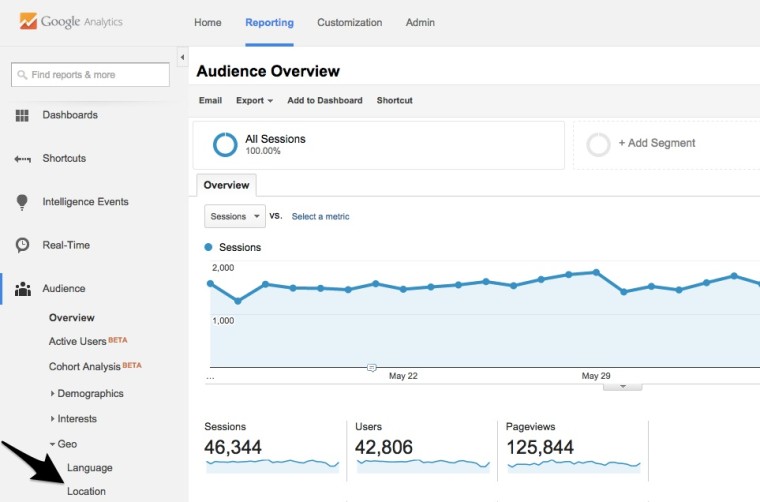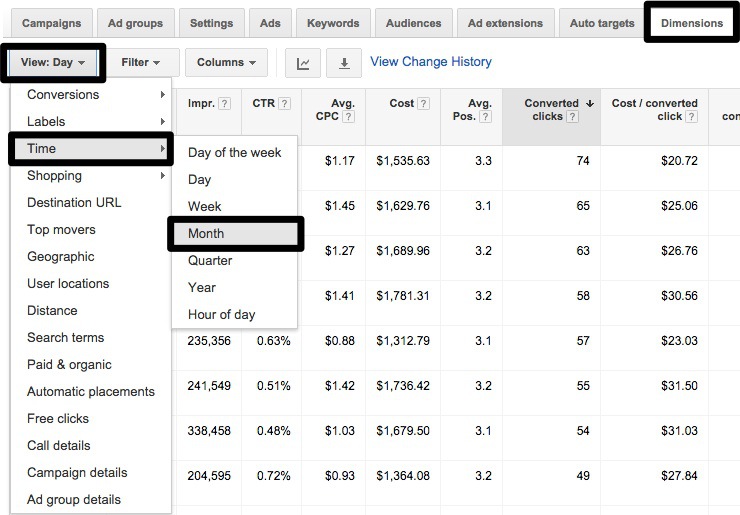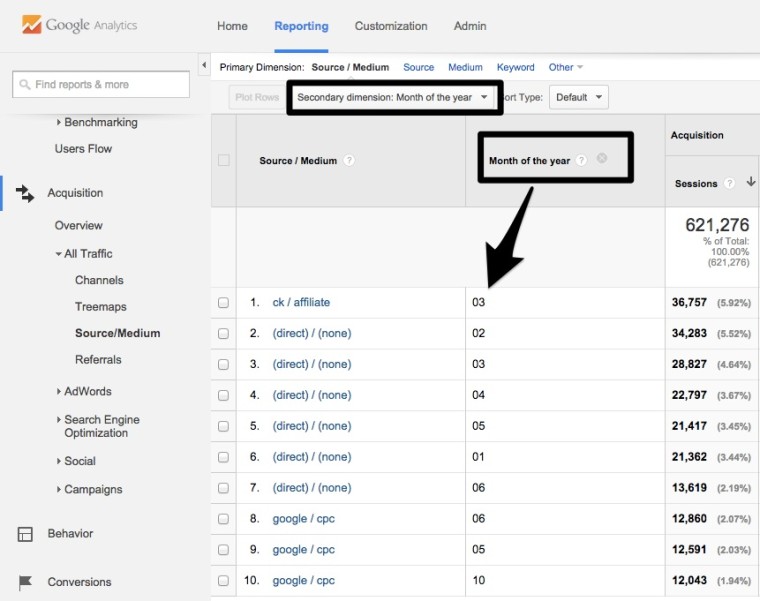The Pareto Principle, also referred to as “The 80/20 Rule,” is frequently used to manage businesses, but can be equally useful to make online marketing decisions. The 80/20 Rule has always been important to me, not only because it was named after an economist (Vilfredo Pareto) from my home country, Italy, but because I always look for the most efficient way to achieve my goals.
This strategy is also valid for campaign management or optimization. While there are hundreds of different ways one could apply the 80/20 rule, here are five ways anyone can implement it instantly and have an immediate effect on campaign performance in AdWords.
#1 Identify the 20% of Locations that Generate 80% of Conversions
The performance of different geographical locations differs greatly for most businesses. This is an opportunity to boost the effectiveness of your campaigns, eliminate the budget on what doesn’t work, and increase your budget for what does work.
In order to analyze the performance of locations in your campaigns, you need to log in to Google Analytics and click “Audiences,” “Geo,” and “Location”. You can look at performance at a country, region or city level:
 Source: Screenshot taken by author. Copyright Rocco Baldassarre.
Source: Screenshot taken by author. Copyright Rocco Baldassarre.Once you identify your top locations by conversions, you can optimize per location on AdWords in two ways:
- Set up bid modifiers for your top locations and reduce bids for the ones that generate traffic but no sales
- Set up a campaign for your best locations to be able to better customize not only bids but also the budget you want to allocate to top performers. Additionally, this saves you a lot of time when it comes to reporting.
 Source: Created by author. Copyright Rocco Baldassarre.
Source: Created by author. Copyright Rocco Baldassarre.You can also push this strategy even further and identify the top one or two locations in your top 20% and create custom landing pages. This is an effective way to increase your conversion rate and get the most out of what is already working.
#2 Identify 20% of the Hours of the Day that Generate 80% of the Conversions
Each product or service converts differently at different times of the day. You should look into your performance by hour and identify the hours that are performing the best to maximize your effectiveness. You can find your performance by hour of the day in the dimension tab in AdWords:
 Source: Screenshot taken by author. Copyright Rocco Baldassarre.
Source: Screenshot taken by author. Copyright Rocco Baldassarre.You can also retrieve the same information via Google Analytics in case you would like to split traffic by source. This comes in handy, particularly if you need to know whether people from different sources behave differently.
Once you identify your top 20% hours of the day, you can maximize performance in one of two ways:
- Apply bid modifiers to boost your top hours and/or decrease costs in the hours that don’t perform as well
- Set up a campaign for your best hours and one for the rest of the hours. This is going to give you both bids and budget flexibility.
The second solution becomes a little more tricky, considering each location might perform differently regarding what hours work best. If you already created campaigns per location, you would have to create duplicates running at different hours of the day.
The second solution is obviously better since it gives you much more control on performance but if you have a small budget or little traffic because you are targeting niches, the first one might be the better choice.
 Source: Created by author. Copyright Rocco Baldassarre.
Source: Created by author. Copyright Rocco Baldassarre.#3 Identify 20% of the Keywords that Generate 80% of the Conversions
Everybody is looking to identify the top performing terms of a campaign to be able to boost results. However, just identifying the terms won’t be enough. What makes the difference is the way you approach the use of these terms.
First of all, start by identifying two types of terms:
- The 20% of the keywords that generate 80% of the conversions
- The 20% of the keywords that generate 80% of the traffic
You can then organize your campaigns as follows:
- Create one campaign for your top keywords by conversions and exclude these terms from any other campaign in the account
- Create one campaign for your top keywords by traffic. Don’t include any keyword that you already included in the campaign for top keywords by conversions. Exclude all the terms that you are using in this campaign from any other campaign in the account
- Keep your original campaign, but don’t target any of the terms from the two new campaigns described above.
 Source: Created by author. Copyright Rocco Baldassarre.
Source: Created by author. Copyright Rocco Baldassarre.Depending on how much control you want, you can decide to break down each campaign based on location and hours:
 Source: Created by author. Copyright Rocco Baldassarre.
Source: Created by author. Copyright Rocco Baldassarre.The second solution is more time-consuming in terms of optimization, but it is definitively worth it if you are planning to scale up your campaigns in the near future.
#4 Identify 20% of Products or Services that Generate 80% of Conversions
Most businesses offer more than one service or product, and each of them contributes differently to the monthly turnover. You can optimize campaigns based on performance reports and focus on what brings in the most profit.
Let’s take the example of a shopping campaign, since it gives us direct insights about sales at a product level.
Once you identified the 20% of the items that generate 80% of the sales, you can:
- Create custom ad groups for the best items and customize the promotion text
- Create a search campaign on Google and Bing
- Create remarketing campaigns both on Google AdWords and social media
Here is a breakdown that includes also the location and bid adjustments mentioned earlier:
 Source: Created by author. Copyright Rocco Baldassarre.
Source: Created by author. Copyright Rocco Baldassarre.Once you set up this new structure you should be able to optimize your campaigns as three independent campaigns and apply best practices for all of them (including additional breakdowns for top locations an hours).
#5 Identify the 20% of the Time of the Year that Generates 80% of the Conversions
Most businesses have a couple of months per year that are the regular high season. Figuring out what months generate the most conversions is fundamental when it comes to allocating marketing budgets. Allocate more budget during high season and reduce the budget for low performing months.
You can find the ad performance by month on AdWords in the dimension tab:
 Source: Screenshot taken by author. Copyright Rocco Baldassarre.
Source: Screenshot taken by author. Copyright Rocco Baldassarre.You can also retrieve the campaign performance per month in Google Analytics and include other traffic sources in your analysis:
 Source: Screenshot taken by author. Copyright Rocco Baldassarre.
Source: Screenshot taken by author. Copyright Rocco Baldassarre. Source: Screenshot taken by author. Copyright Rocco Baldassarre.
Source: Screenshot taken by author. Copyright Rocco Baldassarre.Businesses familiar with the seasonal trends of their industry can anticipate dips and peaks in online demand. This is particularly important for startups with funding, because one way of keeping investors happy is having predictable costs.
Conclusion
Correctly applying the 80/20 Rule to AdWords makes the most and least profitable investments stand out quickly. It can result in pausing less profitable things like ad groups or keywords, in raising the budget to allocate more money to the top 20%, or even in a complete restructuring of the account tree.
Typical mistakes to avoid are going ahead with any changes before you have enough data or taking the percentage literally. The 80/20 Rule works best if it is considered as a mindset, a way of thinking and optimizing campaigns instead of including that one keyword because it is part of the top 20 percent, even though it doesn’t make that much sense. There is always about 10-20 percent that generate the most results, but where exactly you put your money should be a combination of best practices, such as the 80/20 rule, experience, and industry knowledge.
Featured Image: Created by author for SEJ
Screen Shots: Taken By Author





![AI Overviews: We Reverse-Engineered Them So You Don't Have To [+ What You Need To Do Next]](https://www.searchenginejournal.com/wp-content/uploads/2025/04/sidebar1x-455.png)